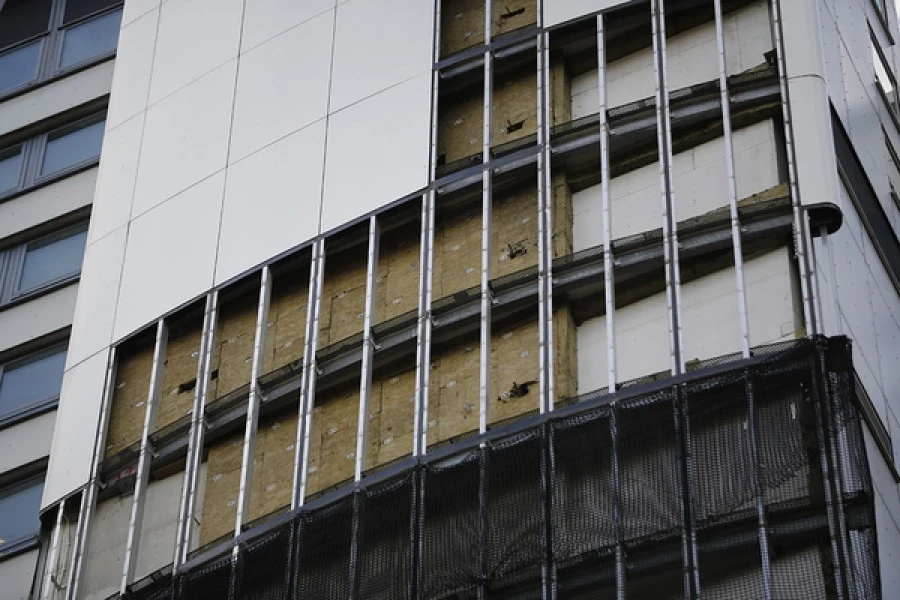Fire protections that stopped flames spreading through insulation systems in government tests could fail in a more realistic environment, according to tests carried out for the insurance industry.
The Fire Protection Association (FPA), a fire safety organisation established by insurers to advise on fire safety, has been conducting tests on the individual components of cladding systems on behalf of the Association of British Insurers (ABI).
These tests are supposed to create a more realistic environment than official government tests carried out by the Building Research Establishment (BRE) over the summer.
Inside Housing can reveal that early tests – designed to check the efficiency of fire breaks rather than the flammability of cladding – have shown “significantly different” results to the government tests.
Unlike the BRE tests, the FPA added windows and vents to the model wall in its laboratory and put burning plastic in the fire lit underneath the structure. These changes contributed to a faster spread, creating a ‘chimney effect’ and bypassing safety mechanisms.
This was to create an “as-built” system, Jonathan O’Neill, managing director at the FPA, told Inside Housing.
Mr O’Neill, who received an OBE last November for services to fire safety, added: “Our initial suspicions were that when you put the systems in as built, you get a different result and from the work we’ve done, this small-scale stuff that we’ve done, that looks absolutely right.
“We’re seeing fire ingress where you wouldn’t have got it on the [government test] rig, because essentially [in that test] you’ve got the insulation perfectly encapsulated.”
Plastic was also added to the test fire to simulate more closely the effects of a cladding blaze. This meant that the fire, in comparison to the wood fire used in the government tests, burned faster and hotter. A government source suggested that if the FPA has any credible evidence the standard should be amended, then they should present it to the British Standards Institution.
Many insulation systems include a cavity between insulation on the outside of buildings and cladding, to protect from rainwater. In this cavity are ‘intumescent’ fire barriers – material which is supposed to expand at a high temperature to prevent the spread of flame.
Government tests showed that these barriers could fail when used with the same cladding that was installed on Grenfell Tower, but concluded that they were safe if the cladding had a fire-retardant core and was used in conjunction with mineral wool insulation. The FPA tests, which were carried out on insulation considered to be fire resistant, showed a swift fire, fuelled by plastic, can surge past the barriers before they can expand and block the chimney.
Update: at 12.45pm on 26.1.2018
This story was updated to make it clear that ACM cladding with a fire retardant core passed tests when used in conjunction with mineral wool insulation. It failed when used with more flammable insulation such as phenolic.
Update: at 12.52pm on 26.1.2018
A government spokesperson said: “Nothing is more important than keeping people safe. The tough and rigorous large-scale fire safety tests we used were developed by the British Standards Institution.
“We commissioned these tests after receiving advice from our independent expert panel on fire safety, who worked closely with the sector.”
THE CLADDING TESTS EXPLAINED
What is the FPA?
The Fire Protection Association was set up in 1880 by what is now called the Association of British Insurers (ABI). It offers education in fire prevention and protection, conducts fire risk assessments and runs a research consultancy.
Why are they testing cladding?
Though the government has tested different cladding combinations, the ABI has asked the FPA – on behalf of its members – to conduct more thorough tests.
What are the differences between these tests and the government tests?
Where the test fire used by the government burned wood, the FPA’s test fire included 10% plastic. The FPA also added penetrations to the insulation where you’d expect windows and vents to be installed in a wall, something the government didn’t do.
What did the tests show?
Adding plastic to the fire – as would be the case if cladding were burning – caused the fire to burn faster and hotter. Penetrating the insulation – as you would a real wall to install windows and vents – meant more flames spread into the cavity from outside, creating a ‘chimney effect’. These factors combined to make safety mechanisms malfunction and the fire spread from floor to floor.
Mr O’Neill, who received an OBE last November for services to fire safety, added: “Our initial suspicions were that when you put the systems in as built, you get a different result and from the work we’ve done, this small-scale stuff that we’ve done, that looks absolutely right.
“We’re seeing fire ingress where you wouldn’t have got it on the [government test] rig, because essentially [in that test] you’ve got the insulation perfectly encapsulated.”
Plastic was also added to the test fire to simulate more closely the effects of a cladding blaze. This meant that the fire, in comparison to the wood fire used in the government tests, burned faster and hotter. A government source suggested that if the FPA has any credible evidence the standard should be amended, then they should present it to the British Standards Institution.





